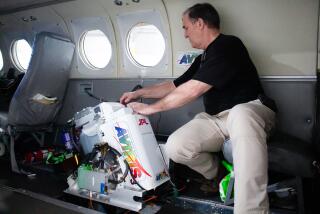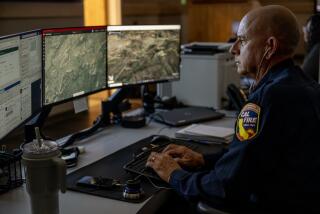NASA sends fleet of small drones to inspect noxious volcano plumes
Getting information on volcanic plumes can be perilous work.
The unbearable heat. The noxious gas. The jagged terrain.
So NASA found a new way to carry out the mission without putting its researchers in danger: drones.
PHOTOS: Americaâs drone fleet
Last month, a team of NASA researchers sent three re-purposed military drones with special instruments into a sulfur dioxide plume emitted by Costa Ricaâs 10,500-foot Turrialba volcano.
The team, led by principal investigator David Pieri of NASAâs Jet Propulsion Laboratory in La Cañada-Flintridge, launched 10 flights involving the small, unmanned spy planes.
The six-pound, twin-electric-engine planes, called Dragon Eyes, recorded video outside and inside the plume. The drones also collected data from several remote-sensing instruments, sulfur dioxide and particle sensors and automatic atmospheric sampling bottles keyed to measure sulfur dioxide concentration.
âScientists believe computer models derived from this study will contribute to safeguarding the National and International Airspace System, and will also improve global climate predictions and mitigate environmental hazards (e.g., sulfur dioxide volcanic smog, or âvogâ) for people who live near volcanoes,â NASA said.
The Dragon Eye drone is built by AeroVironment Inc. The Monrovia company is the Pentagonâs top supplier of small drones -- including the Raven, Wasp and Puma models -- that give troops on the ground a birdâs-eye view of whatâs happening over a ridge or around a bend.
NASAâs use of the technology marks another way institutions have re-purposed robotic aircraft for non-military applications. Drone makers such as AeroVironment would like to sell their technology for use as police helicopters, crop dusters and hobby aircraft.
Currently, drones are not allowed to fly in the U.S. except with special permission from the Federal Aviation Administration. But as technology becomes more advanced and demand increases for using drones in the commercial world, the agency is moving to ease restrictions by 2015.
ALSO:
Southland aerospace firms brace for defense cuts
Boeing working to lift FAA grounding on 787 with test flight
SpaceX splashdown: Capsule returns 2,668 pounds of science samples
More to Read
Inside the business of entertainment
The Wide Shot brings you news, analysis and insights on everything from streaming wars to production â and what it all means for the future.
You may occasionally receive promotional content from the Los Angeles Times.











